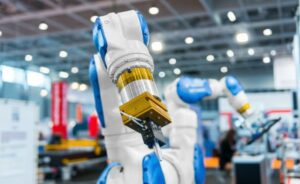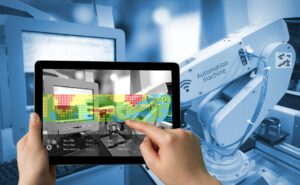
Perhaps the buzzword of this decade is ‘smart’. No industry is exempt from it. From phones to homes and buildings are trying to get the tag. And one industry that is taking serious interest in it is manufacturing. Known by various names, from smart, intelligent factories to the larger concept of industry 4.0, the manufacturing sector is slowly witnessing a revolution that could make its impact felt across several other divisions.
At the heart of any smart factory is intelligence and location intelligence is an essential component of this: if something moves and it is process-critical, you need to know where it is and what it is doing. Industry 4.0 describes an environment in which flexible, intelligent processes leverage real-time data from sensors connected across the entire value chain to enable optimization of industrial processes. These cyber-physical systems leverage big data analytics to translate full operational visibility into unprecedented manufacturing agility and efficiency.
Others point out that the terminology could be different depending on where you are, but the concept remains the same.
There are multiple definitions depending on the region where this topic gets covered. However going beyond the conventional definitions of the terms ‘smart factory’ or ‘industry 4.0’, these terms reflect the fundamental shift in terms of how technology is changing the face of manufacturing processes through ‘connected architecture’. Today various stages of manufacturing processes right up to the lowest level of a machine or equipment are now getting directly connected through sensors/ IoT and are able to communicate directly with each other making the whole chain transparent and more efficient. The machines, the equipment can now be enabled not only to communicate each other but also with their higher and lower systems and to take intelligent decisions independent of human intervention. This is the modern smart factory.
A smart factory is an industry that leverages on IoT devices to improve the efficiency, continuity and security of its operations. Real-time and remote communication among the production components and the operators enables factories to be a showcase for automation. Smart factory concept is defined as two separate phases. For instance, smart factory is part of industry 4.0. Industry 4.0 will include the design phase, manufacturing phase and the logistic phase. The whole thing is called 4.0, but smart factory becomes the middle of the process.
Smart factories need at least four elements. The first one is machine to machine (M2M) integration. The second thing would be the domain knowledge. The third thing would be the business intelligence of the front end and back end. The fourth is the market demand. These four come from four different domains, which means if we want to define smart factory in one word, it is integration.
The idea of dividing the concept into four categories appears to be popular in the industry. Industry 4.0 has four pillars, the smart factory being one of them. But essentially, the way we look at it, there is the smart factory, there is the digital customer experience as another key pillar, there is the connected supply chain and there is the digital enterprise. Any industry 4.0 initiative starts off based on one of these pillars and quickly moves into overlapping areas.
Role of Cameras in Smart Factories

Smart factories can use a wide range of information inputs to feed their decision-making capabilities – video is one of many such sources. It’s used both in sensing and process control (ensuring, for example, that certain process areas are not obstructed by foreign objects) but also in test and QA (for example, making sure that all screws required to assemble a case are actually present in the finished article).
Video data needs a lot of interpretation, and works best where the process and illumination are well-constrained, allowing today’s image processing algorithms to operate at low error rates. In less well-constrained circumstances, direct methods of detecting and identifying objects, e.g. RFID systems, may be preferred.
Cameras inside smart factories are utilised for loss prevention, remote monitoring, operational processes, safety and security. For example, MARLENKA International, a facility producing honey cakes located in the Czech Republic, placed cameras above the production line to monitor the belt conveyor movement and the dough baking process as a result of the industrial standard requirements. Other areas cameras are being used in this facility include the product packing department as well as the dispatch department, for traffic monitoring.
Another example showcasing how cameras are used in smart facilities is with ZAMPRA spol. s.r.o., an international engineering company located in Czech Republic. They used cameras for mainly traditional security reasons, such as protection of the perimeter, theft prevention and monitoring. The cameras asserted themselves in monitoring observance of safety at work and specified work processes; the number of work injuries and unreported absences in the workplace has also decreased. However, very soon it turned out that the exceptional optical quality and software possibilities of the cameras, such as easy searching for records, made it possible to efficiently use the cameras for other activities that greatly optimize operations in production.
Since the launch of the camera system, there has been a demonstrable increase in production quality, growth in production and a reduction in work injuries and unreported absences in the workplace.
There are two scenarios where cameras come into play in the smart factory. First is fault inspection. The main work of the industrial camera is inspecting the degree of accuracy or tolerance needed. Second would be the surveillance, which is a standard application for security.
Adapted from a&s Magazine



































































